When learning a new language, mastering polite phrases is essential. One such phrase is “please.” Understanding how to say “please” in Italian is crucial for smooth communication and showing respect.
The Basics of Saying “Please” in Italian
The most common translation of “please” in Italian is “per favore.” This phrase is used in various situations, from casual to formal settings. When you ask someone to bring the check at a restaurant, you might say, “Mi porta il conto, per favore?” (Could you bring me the check, please?).
Variations of “Please” in Italian
Italian culture has several ways to express politeness. For instance, “per piacere” is another phrase used similarly to “per favore.” Both are widely understood and interchangeable in many contexts. However, there are other phrases to consider:
- “Si prega di” is used in formal written communication.
- “Ti prego” is more personal and often used among family members or close friends.
- “La prego” is a formal way to address someone of higher status or older adults.
Context Matters
Italian people place a high value on manners. Knowing when to use each phrase is vital. In informal settings, “per favore” or “per piacere” will suffice. In formal settings or when addressing someone with higher status, “la prego” is more appropriate.
For example, in a formal spoken situation, you might say, “La prego di non fare troppo rumore” (Please do not make too much noise). In contrast, with family members or friends, you might say, “Ti prego, non fate troppo rumore” (Please, do not make too much noise).
Special Phrases and Usage
Certain phrases emphasize politeness further. “Vi prego” is used when addressing more than one person, adding an extra layer of formality. For example, “Vi prego di mantenere la calma” (Please, keep calm).
When making polite requests, the word “prego” also comes into play. Although “prego” literally means “you’re welcome,” it can be used to say “please” in certain contexts, like when inviting someone to proceed with an action: “Prego, si accomodi” (Please, take a seat).
Politeness in Different Scenarios
Politeness in Italian isn’t limited to spoken language. In written form, phrases like “la preghiamo” are used to address readers frmally. For instance, “La preghiamo di leggere attentamente le istruzioni” (Please read the instructions carefully).
Common Mistakes to Avoid
English speakers often make mistakes when translating directly. The direct translation of “please” doesn’t always fit Italian usage. For example, translating “please” as “per piacere” in every context might sound awkward. Understanding the nuances of each phrase helps avoid such pitfalls.
Practical Examples
Here are a few practical examples to illustrate the use of “please” in Italian:
- Formal Request: “Potrebbe portarmi il conto, per favore?” (Could you bring me the check, please?).
- Informal Request: “Portami il conto, per favore.” (Bring me the check, please).
- Addressing a Group: “Vi prego di fare attenzione.” (Please pay attention).
- Formal Written Communication: “La preghiamo di inviare la documentazione entro domani.” (Please send the documentation by tomorrow).
Learning Italian Politeness
Learning these phrases enhances your communication skills. It shows respect and understanding of Italian culture. Incorporating phrases like “per favore,” “per piacere,” and “la prego” into your vocabulary makes interactions smoother.
The Takeaway
Mastering polite phrases like “please” in Italian is essential for effective communication. Whether you use “per favore,” “ti prego,” or “la preghiamo,” understanding the context and proper usage is key. This knowledge helps in various situations, from casual conversations to formal requests.
Remember, learning Italian goes beyond vocabulary. It’s about understanding the culture and manners that shape the language. So next time you’re in Italy, use these phrases to make polite requests and enjoy smoother interactions. Saying “please” in Italian not only shows good manners but also enriches your language learning experience.
Frequently Asked Questions
How do you say “please” in Italian?
“Please” in Italian is “per favore,” which is an essential phrase to learn Italian.
What is the polite way to ask for the check in Italian?
You can say, “Mi fa portare il conto, per favore?” which is a polite way in formal spoken situations.
How do you use the same verb in both formal and informal requests?
The verb “pregare” is used in both formal speech (“La prego”) and informal contexts (“Ti prego”) to make polite requests.
What are some useful Italian phrases for beginners?
Useful Italian phrases include “per favore” and “grazie,” which are vital for anyone starting to learn Italian.
How is “please” translated literally in Italian?
“Please” is translated literally as “per favore” in Italian, commonly used in various formal spoken situations.








